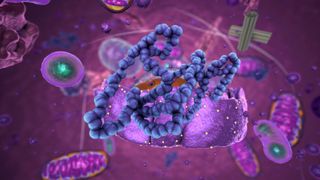DeepMind scientists win $3 million 'Breakthrough Prize' for AI that predicts every protein's structure
The "protein folding problem" was a long-standing hurdle in biology.

Scientists from Google DeepMind have been awarded a $3 million prize for developing an artificial intelligence (AI) system that has predicted how nearly every known protein folds into its 3D shape.
One of this year's Breakthrough Prizes in Life Sciences went to Demis Hassabis, the co-founder and CEO of DeepMind, which created the protein-predicting program known as AlphaFold, and John Jumper, a senior staff research scientist at DeepMind, the Breakthrough Prize Foundation announced Thursday (Sept. 22).
The open-source program makes its predictions based on the sequence of a protein's amino acids, or the molecular units that make up the protein, Live Science previously reported. These individual units link up in a long chain that then gets "folded" into a 3D shape. The 3D structure of a protein dictates what that protein can do, whether that's cutting DNA or tagging dangerous pathogens for destruction, so being able to infer the shape of proteins from their amino acid sequence is incredibly powerful.
The Breakthrough Prizes recognize leading researchers in the fields of fundamental physics, life sciences and mathematics. Each prize comes with a $3 million award, supplied by founding sponsors Sergey Brin; Priscilla Chan and Mark Zuckerberg; Yuri and Julia Milner; and Anne Wojcicki.
Related: 2 scientists win $3 million 'Breakthrough Prize' for mRNA tech behind COVID-19 vaccines
"Proteins are the nano-machines that run cells, and predicting their 3D structure from the sequence of their amino acids is central to understanding the workings of life," the foundation's statement reads. "With their team at DeepMind, Hassabis and Jumper conceived and constructed a deep learning system that accurately and rapidly models the structure of proteins."
Using AlphaFold, the DeepMind team has compiled a database of some 200 million protein structures, including proteins made by plants, bacteria, fungi and animals, Live Science previously reported. This database includes nearly all cataloged proteins known to science.
Sign up for the Live Science daily newsletter now
Get the world’s most fascinating discoveries delivered straight to your inbox.
The AI system "learned" to assemble these shapes by studying known protein structures compiled in existing databases. These protein structures had been painstakingly visualized with a technique called X-ray crystallography, which involves zapping crystalline protein structures with X-rays and then measuring how those rays diffract.
Within these existing databases, AlphaFold identified patterns between proteins' amino acid sequences and their final 3D shapes. Then, using a neural network — an algorithm loosely inspired by how neurons process information in the brain — the AI used this information to iteratively improve its ability to predict protein structures, both known and unknown.
"It’s been so inspiring to see the myriad ways the research community has taken AlphaFold, using it for everything from understanding diseases, to protecting honey bees, to deciphering biological puzzles, to looking deeper into the origins of life itself," Hassabis wrote in a statement published in July.
"As pioneers in the emerging field of 'digital biology', we’re excited to see the huge potential of AI starting to be realised as one of humanity's most useful tools for advancing scientific discovery and understanding the fundamental mechanisms of life," he wrote.
Originally published on Live Science.

Nicoletta Lanese is the health channel editor at Live Science and was previously a news editor and staff writer at the site. She holds a graduate certificate in science communication from UC Santa Cruz and degrees in neuroscience and dance from the University of Florida. Her work has appeared in The Scientist, Science News, the Mercury News, Mongabay and Stanford Medicine Magazine, among other outlets. Based in NYC, she also remains heavily involved in dance and performs in local choreographers' work.
